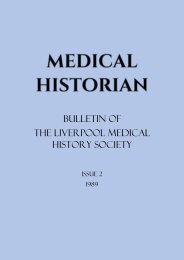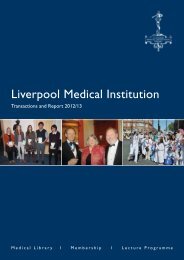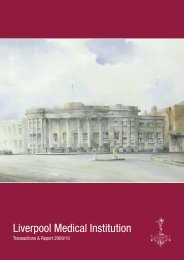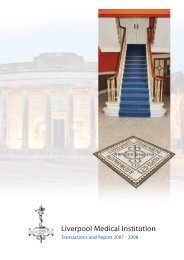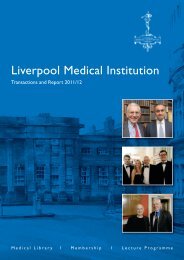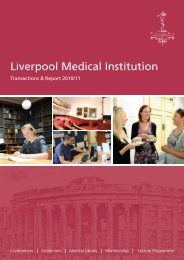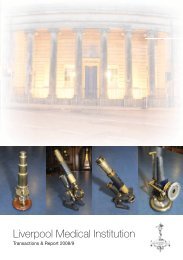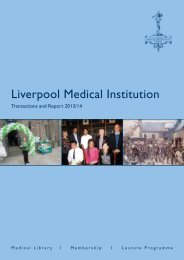LMITransactions&Report2014-15
Create successful ePaper yourself
Turn your PDF publications into a flip-book with our unique Google optimized e-Paper software.
LMI Transactions and Report 2014 - 20<strong>15</strong><br />
generated lack of supplies and prolonged casualty<br />
evacuation to base facilities, with the added risk of<br />
interruption by enemy action. Casualty evacuation<br />
was more difficult during advances or retreats.<br />
Operations also generated new varieties of medical<br />
problems such as shell-shock and gas poisoning on the<br />
Western Front. There was little shell-shock in<br />
Mesopotamia. Relationships with the local population<br />
could be hostile in Mesopotamia and it was always<br />
important to negotiate with the locals.<br />
Geographical factors played a major role. The<br />
prevalence of diseases such as typhoid in the local<br />
civilian population and in animal reservoirs would<br />
influence the likelihood of infecting the soldiers.<br />
There were problems of heat stroke in the Dardanelles<br />
and Mesopotamia, and of frost bite in France. The<br />
terrain in France was flat and there was a pre-existing<br />
infrastructure of roads and railways, although<br />
flooding, wind, snow and ice could be problems.<br />
Casualties in the Dardanelles were evacuated under<br />
fire to poorly-organised medical facilities. Although<br />
these improved compared with the second wave of<br />
landings, there was no space in the bridgeheads and a<br />
lack of resources for anything like what was available<br />
on the Western Front. In Mesopotamia there were no<br />
railways and few roads. Transport was by horse- or<br />
donkey-drawn vehicles over very long distances, until<br />
a river could be reached.<br />
To some extent, technology played a part in ironing<br />
out the differences between the 3 theatres. In<br />
particular, immunisation against typhoid and tetanus<br />
was available in all 3 areas, but immunisation against<br />
cholera was only 50% effective. Each theatre<br />
presented its own unique challenges, but the<br />
difficulties remained greatest outside Europe.<br />
Geographical difficulties could be partly overcome<br />
given sufficient planning and resources.<br />
Operational factors always played a major role. For<br />
the medical services, the relatively static theatre on the<br />
Western Front carried major advantages, allowing<br />
facilities to be built up over a period. Combined<br />
operations such as in the Dardanelles added problems,<br />
with poor communications and rivalry between the<br />
army and navy. When warfare was more widespread,<br />
such as in Mesopotamia, the extended lines of<br />
communication stretching over thousands of miles<br />
With the rising tide of nationhood in the British Empire<br />
it was important that Imperial troops were seen to be<br />
treated fairly. On each side of the conflict, nations<br />
accused each other of poor treatment of prisoners.<br />
Relationships between commanding officers and<br />
medical officers was crucial. The Medical Act of 1858<br />
increased the professionalisation of medicine and the<br />
Royal Army Medical Corps was founded in 1898, giving<br />
medical officers the same ranks as the rest of the army.<br />
However, relations remained strained in the later part<br />
of the Victorian era. In the Boer War the senior<br />
commanders such as Lord Roberts and Sir Garnet<br />
Wolseley had a poor opinion of medical officers and<br />
this view appeared to pass down the chain of<br />
command. There was a great gulf between combatant<br />
officers and medical officers and operational plans<br />
were drawn up without consultation with medical<br />
officers. Advice on water purification, sanitation and<br />
rations was ignored, resulting in 8000 deaths from<br />
typhoid. Consequently public support for the war<br />
declined.<br />
After the Boer War, lessons were learnt. There was<br />
better training of commanding officers in the<br />
importance of hygiene and sanitation. It was thought<br />
that better Japanese medical services had contributed<br />
to their victory in the Russo-Japanese War. The<br />
efficiency and status of the army medical services were<br />
built up by Lieutenant General Sir Alfred Keogh, who<br />
was Director General 1904-1910 and 1914-1918. He<br />
worked well with Lieutenant General Sir Arthur<br />
Sloggett who was in charge of medical services on the<br />
Western Front. Although the rapid expansion of the<br />
army diluted knowledge and caused a relative lack of<br />
training, every effort was made to overcome this. The<br />
High Command on the Western Front was acutely<br />
aware of the connection between good medical<br />
services and morale and the need to provide good<br />
facilities to get soldiers back to their units as soon as<br />
possible.<br />
12




